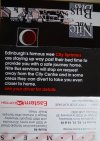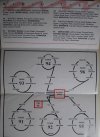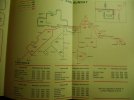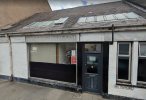tbtc
Veteran Member
Rather than derail the existing thread about McGills, I thought that there was enough discussion/ interest in that older era to warrant a separate thread
There’s been a lot said about Lothian/ LRT during this period but I don’t think I’ve seen any publication devoted to the “green” buses during the same decades (certainly some historic stuff, but nothing post deregulation from what I’d seen)
(For arguments sakes, I’m defining this as any Eastern Scottish services, between 1980 and the takeover by Grampian in 1994, so pre/ post deregulation, the end years of the SBG, the brief independence and rebranding as SMT in the early 1990s)
I lived near Edinburgh at the time, but visits were sporadic, and visits involving the travel office at St Andrew Square Bus Station even rarer (compared to the LRT timetables that could be picked up at Waverley Bridge/ Hanover Street etc), so my knowledge has a lot of gaps, as you’ll see!
A few questions to set the ball rolling (bearing in mind that this was thirty/ forty years ago, and I was never an expert at the time and have forgotten much over the decades…)
1. Eastern/ SMT shrunk over the years (having previously operated from the east end of Glasgow to the English border). I get the argument for chopping it up, given plans to privatise etc, but what did the Linlithgow depot do (before being given to Midland, as they themselves lost various depots to Strathtay/ Kelvin)? Was it just some journeys on the (Stirling?) Falkirk - Linlithgow - A8 - Edinburgh corridor, on a service shared with Midland, plus token infrequent services to Bo’ness? Or did the through running off what were now call the 38/X38 only happen later, and Eastern ran everything east of Linlithgow?
2. The setting up of Lowland Scottish always felt a bit awkward to me, especially in East Lothian, which had nothing much to do with the “core” operation in the Borders (a handful of 104s between Dunbar and the Eyemouth area aside) and created a delicate situation where they had to co-exist with Eastern. Would it have made more sense to give Lowland the Musselburgh depot too, to give them a critical mass in East Lothian? A lot of the redistribution of depots seemed logical (whilst Linlithgow is obviously in West Lothian, in bus terms it fitted better with Midland… I understand the setting up of some of the new companies to create “sellable” packages/ allow more focus in certain areas… but the East Lothian area never seemed big enough for Eastern and Lowland plus the inevitable expansion of LRT post October 1986
3. When the original City Sprinter routes were set up in 1986, my memory is that one of the services (C6?) didn’t go into the city centre (running something like Leith - Lochend - Northfield Broadway - Niddrie?). Sounds “brave” (as they’d say on Yes Minister)… did that last very long, or was it quickly abandoned?
4. We saw on the other thread that the Penicuik buses ran through to Balerno. Some cross-city stuff seemed to work well because it lasted a long time (the 129 linking it’s established eastern section to the Western General and Silverknowes, the 86 going being the city centre to the Zoo/ Corstorphine) some cross city stuff didn’t last too long (certain 16s from Bathgate running to Leith Walk/ Lochend). What did you like/ dislike? I think that there was a complicated equivalent to the LRT 2/12/21 Broomhouse loop, where the “rosewell” and “Gorebridge via Newbattle” routes (79/80?) ran a coordinated fifteen minute service from Gilmerton - Bridges - Princes St - Gorgie Road - Stenhouse - Broomhouse then became a 64A/ 70 and continued via Corstorphine - Murrayfield - Princes Street - Liberton - Burdiehouse (and on to Loanhead/ Roslin/ Penicuik). Am I imagining this, or inferring wrongly from the limited timetable I had access to during that era, or was it really a through bus from Rosewell to Roslin via far flung Broomhouse? Corrections welcome!
5. What seems the most niche corridor to compete on, in hindsight? Or route that had multiple operators but now no commercial service exists? I think that winning the tender for the 38 (Crewe Toll - Balgreen - Morningside - Cameron Toll, similar to the current day Lothian route) encouraged Eastern to directly compete against the eastern bit of the LRT 32/52 by calling their service the 38/58 and continuing beyond Cameron Toll to serve Niddrie - ASDA - Portobello - Lochend - Leith - Granton and back to Crewe Toll that way - with the 58 running clockwise). This was in an era before the new Infirmary/ Ocean Terminal, places which have massively improved the case for some “orbital” links, it felt strange - to me - that they’d choose to compete with the Outer Circle felt a strange decision to me
6. When did routes other than the C5/ C55 become minibus operated? From memory, the C5 was the only one of the C1-C9 to be minibus run, later supplemented by the parallel C55, but a few years later the C1/ C2/ C3 still existed (at at least one end of their 1986 route), and were minibus run. So was there a “second phase” of changes where dozens more minibuses flooded Princes Street (and the C4/ C6/ C7/ C8/ C9 were scrapped)? Or did it happen in phases?
7. Other than the aforementioned C55 and the C12 (City - South Gyle, contra- peak journeys, maybe run by vehicles that had run rush hour expresses from West Lothian and were otherwise running empty to the depot?), the C50 (C5s that served Barberton) which other “C” services were double digit numbers? I ask because the “big bus” routes tended to stay as regular numbers without any prefix
8. Was Lothian always guaranteed to win? Some days I tell myself that Eastern Scottish were bound to lose territory to the “city” operator. They were hamstrung by the costs of a city centre depot (New Street) and the separate bus station too, it was easy for LRT to extend frequent urban services beyond termini like Eastfield/ Gilmerton/burdiehouse into East Lothian/ Midlothian, Eastern were trying to compete for Edinburgh passengers on short distance journeys with “big” buses more suited to longer distance operation (I grew up loving a Leyland Leopard/ Tiger, but would Eastern have been better with a lot more Leyland Nationals instead, buses that felt a lot more “basic” but at least would have meant shorter dwells at bus stops when competing with the dual doored LRT fleet and their generally speedier “exact fare” policy). I know that First’s hubris after the millennium accelerated the demise (trying to replicate the Glasgow Overground in a city where they’d shears played second fiddle), and that a lot of the “bus war” was after the period that this thread relates to SMT being taken over by Grampian), but Eastern Scottish always felt like they were dealt a tough hand of cards, it was inevitable that the “madder” vehicles would take chunks out of traditional “green” territory. Or was it?
I hope that’s enough to get on with for now, I really wish I’d made more effort in the late 1980s to take the detour into the bus station to keep abreast of things (albeit I was probably too young an age to walk around there safely without supervision, it never felt a particularly welcome introduction to Edinburgh for any visitors!). It’s just that in a short space of time Eastern went from an ambitious attempt to win a share of the market in Edinburgh with some relatively innovative* services to struggling to defend their home turf
* - I say “innovative” because they did initially provide some brand new links, running into housing schemes that LRT ignored, giving some suburbs a direct Princes Street link (at a time when LRT has a lot more routes running via George Street/ The Mound/ Royal Mile, nice and diverse but not great when passengers wanted to go to the main shops/ Waverley etc)… much more interesting than the Edinburgh Overground fifteen years later, where First just flooded established Lothian corridors with cheap buses
There’s been a lot said about Lothian/ LRT during this period but I don’t think I’ve seen any publication devoted to the “green” buses during the same decades (certainly some historic stuff, but nothing post deregulation from what I’d seen)
(For arguments sakes, I’m defining this as any Eastern Scottish services, between 1980 and the takeover by Grampian in 1994, so pre/ post deregulation, the end years of the SBG, the brief independence and rebranding as SMT in the early 1990s)
I lived near Edinburgh at the time, but visits were sporadic, and visits involving the travel office at St Andrew Square Bus Station even rarer (compared to the LRT timetables that could be picked up at Waverley Bridge/ Hanover Street etc), so my knowledge has a lot of gaps, as you’ll see!
A few questions to set the ball rolling (bearing in mind that this was thirty/ forty years ago, and I was never an expert at the time and have forgotten much over the decades…)
1. Eastern/ SMT shrunk over the years (having previously operated from the east end of Glasgow to the English border). I get the argument for chopping it up, given plans to privatise etc, but what did the Linlithgow depot do (before being given to Midland, as they themselves lost various depots to Strathtay/ Kelvin)? Was it just some journeys on the (Stirling?) Falkirk - Linlithgow - A8 - Edinburgh corridor, on a service shared with Midland, plus token infrequent services to Bo’ness? Or did the through running off what were now call the 38/X38 only happen later, and Eastern ran everything east of Linlithgow?
2. The setting up of Lowland Scottish always felt a bit awkward to me, especially in East Lothian, which had nothing much to do with the “core” operation in the Borders (a handful of 104s between Dunbar and the Eyemouth area aside) and created a delicate situation where they had to co-exist with Eastern. Would it have made more sense to give Lowland the Musselburgh depot too, to give them a critical mass in East Lothian? A lot of the redistribution of depots seemed logical (whilst Linlithgow is obviously in West Lothian, in bus terms it fitted better with Midland… I understand the setting up of some of the new companies to create “sellable” packages/ allow more focus in certain areas… but the East Lothian area never seemed big enough for Eastern and Lowland plus the inevitable expansion of LRT post October 1986
3. When the original City Sprinter routes were set up in 1986, my memory is that one of the services (C6?) didn’t go into the city centre (running something like Leith - Lochend - Northfield Broadway - Niddrie?). Sounds “brave” (as they’d say on Yes Minister)… did that last very long, or was it quickly abandoned?
4. We saw on the other thread that the Penicuik buses ran through to Balerno. Some cross-city stuff seemed to work well because it lasted a long time (the 129 linking it’s established eastern section to the Western General and Silverknowes, the 86 going being the city centre to the Zoo/ Corstorphine) some cross city stuff didn’t last too long (certain 16s from Bathgate running to Leith Walk/ Lochend). What did you like/ dislike? I think that there was a complicated equivalent to the LRT 2/12/21 Broomhouse loop, where the “rosewell” and “Gorebridge via Newbattle” routes (79/80?) ran a coordinated fifteen minute service from Gilmerton - Bridges - Princes St - Gorgie Road - Stenhouse - Broomhouse then became a 64A/ 70 and continued via Corstorphine - Murrayfield - Princes Street - Liberton - Burdiehouse (and on to Loanhead/ Roslin/ Penicuik). Am I imagining this, or inferring wrongly from the limited timetable I had access to during that era, or was it really a through bus from Rosewell to Roslin via far flung Broomhouse? Corrections welcome!
5. What seems the most niche corridor to compete on, in hindsight? Or route that had multiple operators but now no commercial service exists? I think that winning the tender for the 38 (Crewe Toll - Balgreen - Morningside - Cameron Toll, similar to the current day Lothian route) encouraged Eastern to directly compete against the eastern bit of the LRT 32/52 by calling their service the 38/58 and continuing beyond Cameron Toll to serve Niddrie - ASDA - Portobello - Lochend - Leith - Granton and back to Crewe Toll that way - with the 58 running clockwise). This was in an era before the new Infirmary/ Ocean Terminal, places which have massively improved the case for some “orbital” links, it felt strange - to me - that they’d choose to compete with the Outer Circle felt a strange decision to me
6. When did routes other than the C5/ C55 become minibus operated? From memory, the C5 was the only one of the C1-C9 to be minibus run, later supplemented by the parallel C55, but a few years later the C1/ C2/ C3 still existed (at at least one end of their 1986 route), and were minibus run. So was there a “second phase” of changes where dozens more minibuses flooded Princes Street (and the C4/ C6/ C7/ C8/ C9 were scrapped)? Or did it happen in phases?
7. Other than the aforementioned C55 and the C12 (City - South Gyle, contra- peak journeys, maybe run by vehicles that had run rush hour expresses from West Lothian and were otherwise running empty to the depot?), the C50 (C5s that served Barberton) which other “C” services were double digit numbers? I ask because the “big bus” routes tended to stay as regular numbers without any prefix
8. Was Lothian always guaranteed to win? Some days I tell myself that Eastern Scottish were bound to lose territory to the “city” operator. They were hamstrung by the costs of a city centre depot (New Street) and the separate bus station too, it was easy for LRT to extend frequent urban services beyond termini like Eastfield/ Gilmerton/burdiehouse into East Lothian/ Midlothian, Eastern were trying to compete for Edinburgh passengers on short distance journeys with “big” buses more suited to longer distance operation (I grew up loving a Leyland Leopard/ Tiger, but would Eastern have been better with a lot more Leyland Nationals instead, buses that felt a lot more “basic” but at least would have meant shorter dwells at bus stops when competing with the dual doored LRT fleet and their generally speedier “exact fare” policy). I know that First’s hubris after the millennium accelerated the demise (trying to replicate the Glasgow Overground in a city where they’d shears played second fiddle), and that a lot of the “bus war” was after the period that this thread relates to SMT being taken over by Grampian), but Eastern Scottish always felt like they were dealt a tough hand of cards, it was inevitable that the “madder” vehicles would take chunks out of traditional “green” territory. Or was it?
I hope that’s enough to get on with for now, I really wish I’d made more effort in the late 1980s to take the detour into the bus station to keep abreast of things (albeit I was probably too young an age to walk around there safely without supervision, it never felt a particularly welcome introduction to Edinburgh for any visitors!). It’s just that in a short space of time Eastern went from an ambitious attempt to win a share of the market in Edinburgh with some relatively innovative* services to struggling to defend their home turf
* - I say “innovative” because they did initially provide some brand new links, running into housing schemes that LRT ignored, giving some suburbs a direct Princes Street link (at a time when LRT has a lot more routes running via George Street/ The Mound/ Royal Mile, nice and diverse but not great when passengers wanted to go to the main shops/ Waverley etc)… much more interesting than the Edinburgh Overground fifteen years later, where First just flooded established Lothian corridors with cheap buses





